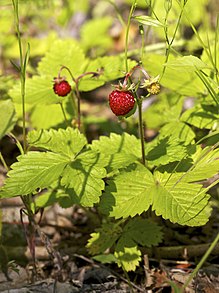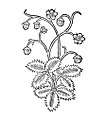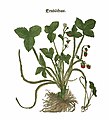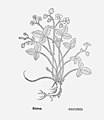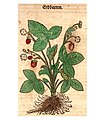Forest strawberry
| Forest strawberry | ||||||||||||
|---|---|---|---|---|---|---|---|---|---|---|---|---|

Forest strawberry ( Fragaria vesca ), illustration |
||||||||||||
| Systematics | ||||||||||||
|
||||||||||||
| Scientific name | ||||||||||||
| Fragaria vesca | ||||||||||||
| L. |
The Wild Strawberry ( Fragaria vesca ), even months strawberry called, is a species of the genus of strawberries ( Fragaria ) within the family of the rose family (Rosaceae). The forest strawberry has long served people as food, as the botanical species name expresses ( vesca = edible). It is also used as a medicinal plant and was often depicted as a symbolic plant in medieval painting. "Bush strawberry" is also used as another common name .
The forest strawberry is not a wild form of the garden strawberry .
Description and ecology
Vegetative characteristics
The forest strawberry is an evergreen , perennial , herbaceous plant . It usually reaches heights of 5 to 25 centimeters and is therefore smaller than the garden strawberry. The leaves stand together in a basal rosette .
Generative characteristics
The flowers appear from April to June and mature over the course of summer. If the sunlight is strong enough, individual plants will bear flowers and fruits even until winter frost. The stems only have a few flowers. The hermaphrodite flowers are radially symmetrical and five-fold. Each flower is surrounded by five small outer sepals . A second, alternating circle is formed by the actual sepals. The flower has five white petals . There are about 20 yellow stamens . The carpels are yellow-green in color. The flowers are female , which prevents self-pollination .
Possibility of confusion
It can be confused with the Indian mock strawberry , which has a similar looking fruit. The musk strawberry ( Fragaria moschata ) is similar, but larger . But while in the wild strawberry the hairs on the peduncle are directed towards the flower, the hairs in the musk strawberry are protruding and point towards the root.
Systematics and number of chromosomes
The forest strawberry is diploid with a chromosome number of 2n = 14 and is not the wild form of the garden strawberry. This is a cross between the chile strawberry ( Fragaria chiloensis ) and the scarlet strawberry ( Fragaria virginiana ), both of which come from the New World .
Propagation Mechanisms
Since a reference by Antoine Furetière (1619–1688) it has been known that the forest strawberry plants either multiply through stolons (runners) or develop fruits and seeds. According to a study published in 2017, this phenomenon is caused by the “FaGA20ox4” gene, which is responsible for the formation of the runners. If a mutation of this gene reduces the production of the phytohormone GA20 from the group of gibberellins , the formation of runners does not occur.
The formation of the common nut fruit
The flowers provide pollinating insects with a high supply of pollen and easily accessible nectar at the base of the flower. Pollinating insects include flies , hover flies , and bees . Ants can also occasionally be observed on the flowers. However, they only lick up the nectar and act as "honey robbers" without having any function in pollination.
From the pollinated flowers the fruits develop, which are called "berries" in German usage, but from a botanical point of view it is a common nut fruit . Each individual carpel of the flower forms a 1 mm long hard-shelled nut. Together with the parallel thickening of the flower axis (which is actually a fruit axis), the fruit is formed from the numerous nuts. With increasing fruit ripeness, the flower axis tissues, which are green when immature, change color to red due to anthocyanins . At the same time, the water content in the flower axis tissue increases and the fruit takes on an intense taste.
Endochory, blastochory, barochory - the ways in which forest strawberries spread
Animals and people who eat the fruit excrete the small, hard-shelled nuts so that the nuts - provided they find suitable site conditions - can germinate (so-called endochory ). Mammals such as red fox , badger , squirrel , hedgehog , bank vole and dormouse ; Birds such as blackbirds , black redstart , robins , blackcaps and invertebrates such as Roman snails , some types of beetles and millipedes are attracted by the red-colored fruits and thus participate in their spread. Ants drag the fruit into their burrows, feed the pulp to their larvae and then carry the remaining nuts out of the burrow.
The forest strawberry does not only use the endochory as a propagation mechanism . Fruits that remain on the stems dry up after a while. The nuts fall down. This mechanism is called barochory . Wild strawberries also reproduce vegetatively. They form long runners that take root and form new rosettes (so-called blastochoria ).
Occurrence
The forest strawberry is native to large parts of Europe and North Asia . It grows preferentially in light deciduous and coniferous forests as well as along the forest edges. The forest strawberry prefers sunny to shady locations and needs moist, but well-drained, nutrient-rich and humus-rich soils . It is a character species of the Epilobietea class in Central Europe , but also occurs in plant communities of the Alliarion or Trifolion medii associations. In the Allgäu Alps, it rises on the Aggenstein in Bavaria to an altitude of 1750 meters.
Use as food
"The cooks have also been warned of the strawberries, they make good mustaches", wrote Hieronymus Bock about the wild strawberry. From archaeological finds we know that wild strawberries have long been one of the fruits collected by humans. In ancient times they were extolled by Roman poets. Ovid , Pliny and Virgil have already dedicated lines to this plant species. In the Middle Ages , wild strawberries were grown on a large scale from the 14th century onwards, but the fruit size was not noticeably increased. The discovery of the larger-fruited Chile strawberry ( Fragaria chiloensis ) and the subsequent crossing with the American scarlet strawberry ( Fragaria virginiana ) meant that the wild strawberry was almost not cultivated since the 18th century. Later, the wild strawberry was used again, which resulted in the monthly strawberry as a cultivated form of the wild strawberry.
Even today, wild strawberries are occasionally used to flavor jams and marmalades . The green kernels of the fruit contain a bitter substance that only appears after a few minutes of cooking. This means that jam made exclusively from wild strawberries can taste bitter.
Monthly strawberries
The forms cultivated today have a longer flowering time than the common wild strawberry and can bear fruit until the onset of frost, the fruits are significantly larger. The vast majority of varieties are cultivated without runners, which instead form crowns with many shoots and numerous flower shoots. They have to be multiplied by division or preferably by sowing, as the vitality of the plants declines after a few years. The first parent of the monthly strawberry is the subspecies Fragaria vesca var. Semperflorens ( Duchesne ) Ser. and on the other hand, the occasional runners-free bush strawberry, Fragaria vesca forma eflagellis . Large-fruited forms have been known in France under the name "Fressant" since the 18th century. Monthly strawberries with runners are suitable as ground cover, varieties without runners as border planting of beds. The white form forma alba , which can be found in natural locations, has also been crossed into the cultivated varieties. In addition, there have been ornamental, sometimes curious varieties for a long time:
Cultivars of Fragaria vesca (selection):
Permanently without runners:
- 'Rügen', originated in the castle nursery in Putbus on Rügen , brought to the market in 1920 by the strawberry grower Emil Spangenberg from Morsleben .
- 'Alexandria', George W. Park Seed Co, USA, 1964
- 'Baron Solemacher', FC Heinemann, Erfurt 1935
- 'Weisse Solemacher' FC Heinemann, 1937, white fruit
- 'Golden Alexandria', golden leaves
With foothills:
- 'Quarantaine de Prin', France, an important market fruit before the First World War, today still grown in tiny quantities in Prin-Deyrançon in the Poitou region , bearing several times
- 'Blanc Amélioré', Great Britain, white fruity with large fruits of the Fressant type
- ' Illa Martin ', Germany, offered as an ornamental plant, bearing several times with elongated white fruits; Plants on the market are mostly not true-to-variety.
- 'Gartenfreude', Germany, large-fruited, several times in foal
- 'Monophylla', strawberry from Versailles, instead of the usually three-part only one large leaf; virescent flowers
- 'Multiplex', double flowering, very low fruit yield
- 'Muricata', " Plymouth Strawberry"; instead of the nuts, the fruit is covered with tiny leaves; virescent flowers
Herbal medicinal use
Due to the tannin content, strawberry leaves are used as a remedy for diarrhea. The younger strawberry leaves are also used as a substitute for black tea. To make tea, finely chopped and dried leaves are poured over boiling water and strained after a few minutes. In the case of diarrhea, drinking this tea several times a day was recommended.
In the current edition of the German Medicines Codex 2008, strawberry leaves are monographed as Fragariae folium . The Federal Health Office assesses the effectiveness and harmlessness as follows:
"As the effectiveness in the claimed fields of application has not been sufficiently proven, therapeutic use cannot be advocated. There are no objections to its use as a filling drug in tea blends. The use of strawberry leaves as a tea drug is also assigned to the food sector. "
Carl von Linné - who described the forest strawberry in his Species Plantarum in 1753 - is said to have freed himself from gout through a cure with strawberry leaf tea and fresh wild strawberries.
ingredients
Strawberry leaves contain condensed tannins , ellagitannins such as peduncluagin and agrimoniin, as well as flavonoids and leucoanthocyanins . Ascorbic acid is only present in small amounts and essential oil only in very small amounts.
The forest strawberry in fairy tales and legends
The wild strawberry plays a role in many legends and fairy tales . In Germanic mythology , the wild strawberry is associated with the goddess Frigg . She is said to have hidden the dead children in strawberries so that she could then take them to Valhalla undetected . According to a legend, the Mother of God Mary is supposed to descend from paradise to earth once a year to collect strawberries for the children who have died and are now living in paradise.
Strawberries appear in one of the fairy tales collected by the Brothers Grimm : In The Three Little Men in the Forest , an angry stepmother lets the heroine, wearing only a paper dress, look for strawberries in the middle of the dead of winter. Her search leads her to the three little men who reward the heroine for their helpfulness.
The forest strawberry in art
Wild strawberries have long been a symbol of lust for the world, temptation and the pleasure of the senses. Christianity has given the wild strawberry a second meaning. It is the plant with the rose-shaped flowers that does not develop thorns, the berries of which are without a core or shell, which both fruit and bloom. She therefore became a symbol of righteousness and the plant that accompanies Mary on medieval panel paintings. Therefore, if a flowering strawberry plant appears in a painting of Christian art, it is also to be understood as an allegory of pious and good thoughts.
history
swell
- Antiquity - late antiquity: Pliny 1st century --- Pseudo-Apuleius 6th century
- Latin Middle Ages: Hildegard von Bingen 12th century --- Frankfurt, ms. Germ. Qu. 17, 1st quarter of the 15th century --- Cpg 226 1459–1469 --- Cpg 558 1470–1485 --- Cpg 545 1474 --- Michael Puff 15th century --- Nikolaus Frauenlob 15th century --- Herbarius Moguntinus 1484 --- Gart der Gesundheit 1485 --- Hortus sanitatis 1491 --- Hieronymus Brunschwig 1500
- Modern times: Otto Brunfels 1532 --- Hieronymus Bock 1539 --- Leonhart Fuchs 1543 --- Mattioli / Handsch / Camerarius 1586 --- Nicolas Lémery 1699/1721 --- Onomatologia medica completa 1755 --- Jean-Louis Alibert 1805 / 05
Historical illustrations
Pseudo-Apuleius Leiden 6th century. Fraga
Herbarius Moguntinus 1484. Fragaria erperkrut
Gart der Gesundheit 1485. Question drowned
Hortus sanitatis 1491. Fragaria
Otto Brunfels 1532. Erdtbörkraut
Leonhart Fuchs 1543. Strawberry
Hieronymus Bock 1546. Strawberries
Mattioli / Handsch / Camerarius 1586
literature
- Detlev Arens : Sixty native wild plants in vivid portraits . Cologne 1991.
- Marianne Beuchert : Symbolism of Plants - From Columbine to Cypress . Frankfurt am Main 1995.
- Esther Gallwitz: Small herb garden. Herbs and flowers at the old masters in the Städel. Insel, Frankfurt am Main 1996, ISBN 3-458-33518-8 .
- Heinz-Dieter Krausch : Imperial crown and peonies red ... - Discovery and introduction of our garden flowers . Dölling and Galitz, Hamburg 2003, ISBN 3-935549-23-7 .
- Angelika Lüttig, Juliane box: Rosehip & Co . Flowers, fruits and spread of European plants. Fauna, Nottuln 2003, ISBN 3-935980-90-6 .
- Siegfried Schlosser (Ed.), Lutz Reichhoff, Peter Hanelt et al .: Wild Plants of Central Europe: Use and Protection . Deutscher Landwirtschaftsverlag, Berlin 1991, ISBN 3-331-00301-8 .
Web links
- Fragaria vesca L., forest strawberry. In: FloraWeb.de.
- Profile and distribution map for Bavaria . In: Botanical Information Hub of Bavaria .
- Fragaria vesca L. In: Info Flora , the national data and information center for Swiss flora . Retrieved November 7, 2015.
- Distribution in the northern hemisphere according to: Eric Hultén , Magnus Fries: Atlas of North European vascular plants 1986, ISBN 3-87429-263-0 .
- Thomas Meyer: Data sheet with identification key and photos at Flora-de: Flora von Deutschland (old name of the website: Flowers in Swabia ).
- Genome sequenced
Individual evidence
- ^ Georg August Pritzel , Carl Jessen : The German folk names of plants. New contribution to the German linguistic treasure. Philipp Cohen, Hannover 1882, p. 154. ( online ).
- ^ Dierend, Werner .: Strawberry cultivation . Ulmer, Stuttgart 2012, ISBN 978-3-8001-5982-6 .
- ^ Manfred A. Fischer, Karl Oswald, Wolfgang Adler: Excursion flora for Austria, Liechtenstein and South Tyrol . 3rd, improved edition. Province of Upper Austria, Biology Center of the Upper Austrian State Museums, Linz 2008, ISBN 978-3-85474-187-9 , p. 487 .
- ↑ Tracey Tenreira, Maria Joao Pimenta Lange, Theo Lange et al .: A Specific Gibberellin 20-oxidase Dictates the Flowering-Runnering Decision in Diploid Strawberry. In: The Plant Cell Online. Volume 29, No. 8, September 2017, doi: 10.1105 / tpc.16.00949 ( full text ; PDF).
- ^ Erich Oberdorfer : Plant-sociological excursion flora for Germany and neighboring areas . With the collaboration of Angelika Schwabe and Theo Müller. 8th, heavily revised and expanded edition. Eugen Ulmer, Stuttgart (Hohenheim) 2001, ISBN 3-8001-3131-5 , pp. 543 .
- ↑ Erhard Dörr, Wolfgang Lippert : Flora of the Allgäu and its surroundings. Volume 2, IHW-Verlag, Eching near Munich, 2004, ISBN 3-930167-61-1 , p. 78.
- ↑ Günter Staudt : Les dessins d'Antoine Nicolas Duchesne pour son Histoire naturelle des fraisiers. Museum of Nat. d'histoire Naturelle, Paris 2003.
- ↑ Brigitte Wachsmuth: Annotated List Alpine, Wild, and Musk Strawberry Varieties Currently in Cultivation .
- ^ A b Max Wichtl (ed.), Franz-Christian Czygan: Tea drugs and phytopharmaceuticals: A manual for practice on a scientific basis. 2nd Edition. Wissenschaftliche Verlagsgesellschaft, Stuttgart 1989, ISBN 3-8047-1009-3 .
- ↑ Federal Gazette No. 22a of February 1, 1990.
- ↑ Eberhard Scholz: Fragaria . In: Hager's Handbook of Pharmaceutical Practice . 5th edition. Volume 5 (Drugs E-O), Springer, Berlin etc. 1993, ISBN 3-540-52638-2 , pp. 181-188.
- ↑ Linnaeus, C. von 1753. Species Plantarum, Tomus I: 494. Retrieved May 21, 2018 .
- ↑ Pliny the Elder , 1st century: Naturalis historia Book XXI, Chapter 50 (§ 86) (digitized version) ; Translation Külb 1855 (digitized version )
- ↑ First printing: Rome 1481, chapter 38: Herba fraga (digitized version ) . According to the list drawn up by Kai Brodersen (Apuleius… 2015, p. 211), the question chapter is neither concordant with the Naturalis historia of Pliny nor with the Medicina Plinii .
- ^ Charles Victor Daremberg and Friedrich Anton Reuss (1810–1868). S. Hildegardis Abbatissae Subtilitatum Diversarum Naturarum Creaturarum Libri Novem. Physica , Book I, Chapter 170: Erper . Migne, Paris 1855. Sp. 1194 (digitized version ) - Translation: Herbert Reier: Hildegard von Bingen Physica. Translated into German after the text edition by JP Migne, Paris 1882. Kiel 1980, p. 30: The herb in which erpere arises is more warm than cold. But it is eaten slim in humans and is not suitable for medicine. The Erper fruits cause slimness in people who eat them and are not suitable for healthy or sick people because they grow next to the earth also in putrid air.
- ↑ Frankfurt, ms. Germ. Qu. 17, Alsace, 1st quarter of the 15th century, sheet 343ra: Erper krut water is good for the gilwe and for other bad heat and to the days that are red, it should be all morning and all near it in strokes and strokes make wit vmb the breast vnd veget the lungs one should do it for drinking (digitized)
- ↑ Cpg 226 , Alsace 1459–1469, sheet 102v: Erper water is well pressed in front of the gilwe vnd machet wyt vmb the breast vnd sweeps the lungs and whoever has red eyes the line has enjoyed the water every morning and every night (digitalisat )
- ↑ Cpg 558 , Northern Bavaria, around 1470–1485, sheet 24r-v: Erper water is good who vnraÿn boßen swaÿß has jn jm vnd jnvendig bad hicze and quench the thirst and drive away the stain and even makes well-blued people with wine drunk or sustained And it is also good for those who have few people in their mouths: and they also have something to drink in their mouths jn the gurgle in the throat she helps them: and is well drunk against the stinking mouth: and is also good the dÿe do speechless leagues and daz you give ÿm daz to nibble: daz help wol: and is also good to the main and to the heart daz creates it wol and is also good for women to be sick and is against then to be removed and removed is also gütt given a bain is the haÿlz it vnd all bain vnd wounds do with ze vaschen haÿlet even sere / and who wounds ettwo who in the body where it who who should you give it to drink . (Digitized version)
- ↑ Cpg 545 Nuremberg (?) 1474, sheet 118r-v: Erper water for poes sweis vnd hicz Item Erper water is good who has poisonous swaiss yn ym vnd ynwendig poss hicz So he drinks the water so it pade wil So drives it away den swais for the thirst and is good for the thirst It also sells the stone mouth fewl Item mixed with wine and drunk or eaten in it makes good plut and is good for the mouth fewl kelen wee Vnd whoever yn the kelen wee see the sol man There is a gurgling for the stinking adtem and is well drunk against the stinking adtem to whom he spoke and it should also help those who speak so that you can drink it to the hood and is good for the hood and it also creates that hercz zu der frawen sucht swint sucht Vnd is good for the frawen to ir sickness So they drink it and it is painful against the loss in the body and it is painful so that you can drink it and wash yourself with it to the sore vnd where someone was sore when he was rinckt and do with wescht heals wounds from the ground up and so ymant yn agile sore or painful were pruchig so he drinks the water so he heals (digitized) . --- Sheet 118v: The erper herb for the stone Item Erper herb water is even medicinally drunk and I do not know any valued art for the stone dan erper herb and eyssen herb and spicy away the drew equally done to each other and drank evenly that drives the stone lindlicher and I learned it yn a monastery who hern vil helped yn do with (digitized)
- ↑ Michael Puff : Booklet of the burnt-out waters . 15th century print Augsburg (Johannes Bämler) 1478 (digitized)
- ↑ Nikolaus Frauenlob 15th century Cpg 583 , South-West Germany (Mattighofen), 1482–1486, sheets 27r – 27v (digitized version ) . Transcription ( rubricated places in bold ): Erper has iiij tugent. Whether a person is not funny or grumpy . Man sal erper krawt jn water whale south and drinking from it that makes people funny and also pissed off. A special ercznej from erper vnd vom kraut . Man sal Erperkrawt juice nemen vnd darjnn white pepper ze poke vnd sally drink That helps the dy da vast gasp and helps the stomach and the prust and the scratched and the platter and manigerlaÿ things. Whom the milk we do or whose stomach is too much hot. One sips pissed off and mixes the juice with half as vil honey and sips the drink that helps the milk and refreshes the stomach even whale. Anyone who goes against the february will not help. Man sal erppleter jn wine whale boil and drink from it ee and jn the fever. --- Cpg 666 , Kurpfalz, 1478–1480, sheet 113r (digitized version ) Transcription: E rper vnd jr kraut has iiij virtue a Whether man is jovial and disgruntled Man [sal] erper jn water whale syden and dor abe drink there the people funny and disaffected b A special Erczneÿ from Erper Man sal erper kraut juice nemen vnd dor jnne white pepper to drink and salt to drink it helps the dy vast keychen and helps the stomach and the puff and the scrap and the splatter c who there milcze we do vein of the stomach almost heatedly is one vnd to push sal erper pleter the Safft with halp so vil honey mix vnd sal daz divertising daz hilfft the milcz vnd refreshes the stomach d Who jme resist dy febres helffen wil Man sal erper pleter jn wine wal syden vnd dor von trincken e daz jn dy febres ruren
- ↑ Herbarius Moguntinus , Mainz 1484, Part I, Chapter 63: Fragaria. Erper krut (digitized version )
- ↑ Gart der Gesundheit . Mainz 1485, Chapter 190: Question. Ertbern (digitized version )
- ↑ Hortus sanitatis 1491, Mainz 1491, Part I, Chapter 188: Fragaria (digitized version)
- ↑ Hieronymus Brunschwig : Small distilling book , Strasbourg 1500, sheet 41r – 42r: Erdtber (digitized version )
- ^ Otto Brunfels : Contrafayt Kreüterbůch . Johann Schott, Strasbourg 1532, S 200: Erdtbörkraut (digitized version )
- ↑ Hieronymus Bock : New Kreütter Bůch . Wendel Rihel, Strasbourg 1539, part I, chapter 170: Earth tuberosity (digitized version )
- ↑ Leonhart Fuchs : New Kreütterbuch… Michael Isingrin, Basel 1543, chapter 329: Erdtbeerkraut (digitized version )
- ^ Pietro Andrea Mattioli : Commentarii, in libros sex Pedacii Dioscoridis Anazarbei, de medica materia. Translation by Georg Handsch, edited by Joachim Camerarius the Younger , Johan Feyerabend, Franckfurt am Mayn 1586, sheet 355r – 356r: Strawberries (digitized version )
- ↑ Nicolas Lémery : Dictionnaire universel des drogues simples. , Paris 1699, p. 308: Fragaria (digitized version) ; Translation. Complete material lexicon. Initially drafted in French, but now after the third edition, which has been enlarged by a large [...] edition, translated into high German / By Christoph Friedrich Richtern, [...]. Leipzig: Johann Friedrich Braun, 1721, column 466: Fragaria (digitized version)
- ↑ Albrecht von Haller (editor): Onomatologia medica completa or Medicinisches Lexicon which explains all names and artificial words which are peculiar to the science of medicine and the art of pharmacy clearly and completely [...]. Gaumische Handlung, Ulm / Frankfurt am Main / Leipzig 1755, Sp. 671: Fraga (digitized version )
- ^ Jean-Louis Alibert : Nouveaux éléments de thérapeutique et de matière médicale. Crapart, Paris Volume I 1803, pp. 553-554: Fraisier. Radix, herba Fragariae (digitized version)

